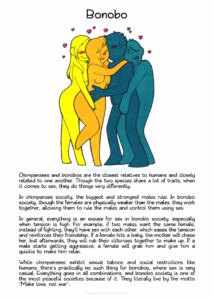 Have you heard that bonobos are peaceful, matriarchal apes that use lots of free sex to obtain delightful egalitarian community? You’ve been lied to. The popular account of these wonderful apes is more faux-nobo than bonobo.
Have you heard that bonobos are peaceful, matriarchal apes that use lots of free sex to obtain delightful egalitarian community? You’ve been lied to. The popular account of these wonderful apes is more faux-nobo than bonobo.
Last year, Lynn Saxon published “The Naked Bonobo“, a book debunking the feel-good, fact-light modern mythology surrounding bonobos in the public imagination. This is a review and summary of that book.
Preface
I have written twice on the subject of popular bonobo nonsense perpetuated by Christopher Ryan and the media. I recommend reading those short posts first [1] [2], particularly the second in which a primatologist who studies bonobos weighed in to correct the record (Questioning the Sexy Bonobo Hype, Part 2: A primatologist corrects Christopher Ryan).
If you’re just tuning in, this topic is highly politically-charged. Bonobo sexuality has been used (injudiciously, I would argue) to advance such worthy causes as greater sexual liberty, tolerance for polyamory, and reducing backward social norms of strict monogamy. My criticism isn’t motivated by opposition to these political and moral ideals- I support them. I think that Lynn Saxon would agree that this debunking is necessary because the faux-nobo mythos is dishonest, manipulative, anti-science, and feeds an unhealthy liberal dogmatism that misinforms the public and threatens free academic inquiry. Thus the original disclaimer from my first bonobo essay:
I am not arguing for monogamy or for conventional sex roles or any such thing, nor against casual sex. Indeed, the meaning that I think we should not trash is inclusive of the various arrangements. Regardless of the whys, humans have loads of variation in what sorts of relationships they want to have. Provide no harm is involved, adults should be at liberty to live as they choose and fornicate with whomever they wish to. We don’t need to believe anything about our species history to think that, we only need to reason about basic ethics of fairness and use a little common sense. All else the same, freedom is better. There’s no sound moral argument to the contrary, whether or not we survey what other apes think about it.
“Naked Bonobo” lives up to its title
Usually debunkings of pseudoscience and sensational claims are mundane, if satisfying. It usually sounds like “GMOs are fine” or “The psychic is a fraud.” Not this time. The truth about bonobos is more shocking, salacious, and captivating than the lies are. I knew that “Bonobo” was going to concern itself with correcting popular bonobo myths, but there were still many surprises. It’s one of the page-turniest debunkings I have ever read. As fascinating as the material is, Saxon delivers it with a steady grace and restrained humor that keeps it light, but not too light.
“The Naked Bonobo” is a meticulous summary of the published scientific sexuality and aggression research on bonobos. It is presented in a digestible pop-science book form. Saxon is to be commended for the herculean work of researching a sector of primatology and recounting it in this highly readable sub-200 page book.
Pt 2 both #TheClothedApe and #TheNakedBonobo are good reads. The Naked Bonobo has a very thorough review of bonobo socio-sexual behavior
— Craig Stanford (@craigstanford7) April 12, 2016
Craig Stanford is Professor of Anthropology and Biological Sciences at USC and Co-Director of the Jane Goodall Research Center
My strongest criticism is that the book bogs down in one or two points in which several statistics are presented serially within a passage. This makes for a thorough treatment, but it can be taxing on the reader. This information could probably have been presented better in other ways. However, this is a minor gripe that doesn’t detract from the overall product. I would also have liked an index.
Letter to the “wannabe”

The book addresses four popular beliefs about bonobos:
- Bonobos are hypersexual apes…
- That are egalitarian and peaceful thanks to that hypersexuality.
- Bonobos are matriarchal, and that for all of these reasons…
- Humans are like or should envy bonobos.
Media sites reinforcing these beliefs: Huffington Post, Salon, LiveScience, CBS News.
These are seductive ideas for many progressivists and feminists. Saxon terms those who have been misled by deceptive bonobo popularizers “bonobo wannabes”. In the book, she regularly refers to the “wannabe”, challenging them to ponder if the bonobo way is really for them after all. The last chapter explores the logical entailments of the hyped “positive” aspects of faux-nobo, shattering the illusion using knowledge about actual bonobo life. It is sure to give any “wannabe” pause.
Saxon fact-checks the claims
A small sample of the evidences presented in “The Naked Bonobo”
1. Are bonobos hypersexual?
This is a bundle of related claims: sex is a “bonobo handshake”, bonobos are constantly interested in and having sex with whomever, and bonobos are more libidinous than chimpanzees or any other apes. According to Saxon, each of these claims is a great distortion of actual bonobo life:
At the Yerkes Regional Primate Center, observations led to the conclusion that sexual behavior occurred only when animals were fed. . . no sexual behavior was observed at any other time of the day between 9:00 a.m. and 4:00 p.m. The bonobos even refrained from sex in 2 of the 17 observed feeding sessions. (p. 51)
A study of the E1 community covered 97 days… 109 copulations were recorded. …This total of 109 copulations over 97 days is hardly more than an average copulation rate of one per day amongst all of these bonobos. (p. 58-9)
This community included 19 sexually mature adults. That’s not ~1/day per bonobo, it is ~1/day for 19 adults. 88% of these observations took place away from the feeding site, which shows what a big difference the setting of observations can make.
A comparison of Gombe and Mahale chimpanzees with Wamba bonobos found the copulation rates of adult male bonobos to be equal to or lower than those of the adult male chimpanzees. As for the adolescent males, the young chimpanzees were getting more than their bonobo counterparts (Takahata e al. 1996).
What? Well, what about females?
…[oestrus] female bonobos were less actively interested in sex than were female chimpanzees. This finding has also been confirmed in a later study of the Kalunzi forest chimpanzees, as the females there were found to actively initiate sex more often than female bonobos (Furuichi and Hasimoto 2002). (p. 70)
In a study of the E1 community at Wamba, Furuichi found that 6 of the 10 females only mated when their swellings were at maximum firmness. (p. 68)
So what went wrong?
Observing bonobos in their remote forest habitat is very difficult. For this reason, writes Saxon, early research frequently focused on captive bonobos and artificial feeding sites. These groups were often quite small, had many sub-adult bonobos, and, of course, the captive bonobos were not living in natural settings. Juvenile and adolescent bonobos turned out to be far more sexually inclined than adults are. Rich concentrated food stores (artificial feeding sites) induce near-panic in bonobo groups and this provokes sexual behavior. It is not representative of typical bonobo life in the African wild.
2. Are bonobos egalitarian and peaceful due to their “make love not war” ways?
Let’s start with, are they peaceful? More than chimpanzees? Saxon writes that bonobos seem to be more peaceable than chimpanzees in a couple of respects. Chimpanzees form patrols and team up to battle rival groups. They do not tolerate overlapping ranges. Bonobos don’t patrol and tend to avoid contact with other groups; their ranges can overlap. Within groups, there is less lethal violence when fights do break out among bonobos and infanticide is rare at best.
That said, bonobo society is far from peaceful and bonobos are far from gentle.
- Kano (1992) found a majority of one group’s individuals had “abnormalities” of the limbs, digits, ears, eyeballs, genitalia, and other parts. 28 counts of total loss of a finger or toe, 96 counts of partial loss. Only one of the 22 adult males had intact fingers and toes. 32 counts of ear lacerations which almost always result from fighting. (p. 117-8)
- At Apenheul Zoo in the Netherlands, five female bonobos attacked a male and were seen gnawing on his toes; the flesh could be seen between their teeth as they chewed away. (p. 119)
- At least two zookeepers have lost parts of digits (p. 119)
- While releasing bonobos back into the wild after rehabilitation at a sanctuary, three trackers were attacked and mutilated. They lost noses, bits of fingers and one lost an ear. One of the men spent a month in the hospital and two required a year of reconstructive facial surgery. (p. 122)
- Overall, male-male aggression rates are similar in chimpanzees and bonobos (p. 126)
Video: a gang of females attack an adolescent male as its mother tries to peel them off. The researchers observing said that the male appeared to have been “at the wrong place at the wrong time.” I wonder why these peaceful apes didn’t resolve their problem- a single adolescent male- with sex instead of mob violence.
Female aggression toward infants and other females
- The alpha female at Twycross Zoo took the infant of the lowest ranking female, even though she was still nursing her own infant. After weeks of rough treatment at the alpha’s hands, she lost interest and the infant had to be removed for human rearing as it showed signs of “weakness and dehydration”. (p. 120-121)
- There are at least 8 cases of infant abduction or victim of aggressive behavior at the Plankendael and Stuttgart zoos; the mothers of the stolen infants behaved nervously and showed signs of distress. While trying to get their infants back, some of the females would present for genito-genital rubbing. (p. 121)
Is there anything sexier than bartering a sex act for your baby’s life?
- In one Lomako group, aggression between females was about 7 times higher when two or more oestrous females were in the party than when there was only one. (p. 124)
I thought that females were keeping the peace with sex, not causing fights over sex?
Next, are bonobos egalitarian? That is, are various goods and resources (food, sex, social support) more evenly distributed among individuals? Chimpanzees are thought to have the opposite arrangement, a more rigid rank system that greatly privileges the chimp elites. Saxon writes that bonobos are probably somewhat more egalitarian than chimpanzees, but much less so than is commonly supposed. Sometimes, it is not clear that there is a difference at all.
- A female-biased sex ratio is taken to be evidence of male intrasexual competition. Competition is a physiologically taxing and risky enterprise that leads to early death for many males. The problem here is that, overall, the sex ratio of chimpanzees and bonobos is very similar.
- Both females and males had higher mating rates when they were aggressors compared to when they were targets of aggression. (p. 124)
- Bonobo society, including its females, rewards rank and aggression:
- Females strongly prefer high ranking males. When in oestrus, this preference intensifies.
- High ranking males are more aggressive, and actively block other males from access to fertile females.
- Ranking female “wingmoms” aid their sons (but not daughters) in bullying and picking fights to advance their status. (p. 115)
- Feeding is highly segmented by rank. Low ranking individuals may be charged or attacked if attempting to line-jump.
- Female bonobos disperse to other groups around adolescence. When accepted in their new group, they solicit sex acts from higher ranking males at food sites. This behavior, and their total libido, drops substantially as they gain rank. In order words, they’re forced to barter sex for food. Not because they’re eager for sexual contact. When they don’t have to, they don’t. Few consider coerced prostitution a sign of gender equality.
3. Are bonobos matriarchal?
Some scholars would say that they are. Others disagree, asserting instead that rank and dominance aren’t really functions of sex. Saxon argues that across all bonobo studies, the idea that females are generally in charge and decide about who copulates with whom, is unsupported. Like the hyper-sexed image, these observations originated mostly in small, captive groups. In contrast, she writes, Research at both Lomako and LuiKotale has found little support for the view that females form these alliances to collectively defend themselves against males. [At LuiKotale] of the 136 acts of aggression by a male towards a female, only 2% led to a female coalition against the male (p. 157-8). Some other flies in the matriarchal ointment:
- Females routinely treat other females with indifference, aggression, or outright brutality (see above).
- Females are “sexy” often in a coercive context of needing to placate ranking females or males in order to eat or not suffer assault.
- The primary beneficiaries of high female status are males: their sons. In what matriarchy do males inherit rank, but females do not?
- High ranking males can outrank many females. The opposite does not happen in “patriarchal” chimpanzee society.
- Rather than moderate, females often reward males for their aggression and dominance (as long as they are its beneficiary rather than its victim).
- Egalitarianism means that rank hierarchies themselves are weak or absent. But it is impossible to sensibly discuss bonobo social life without constant awareness of rank and the associated social politics.
4. Should humans envy bonobos?
Perhaps the most important idea in this book is that the “great” parts of the faux-nobo lifestyle wannabes want us to emulate, properly understood, become disturbing if not nightmares outright:
“Sexy” bonobos have the most frequent sex as sub-adults and sexual contact between juveniles, infants, and adults is quite common and normal.
“Tension-reducing” sex among bonobos is most often not about fun. It is not about enthusiastic consent, but coercion on threat of aggression. Like humans, we know that bonobos have preferred sexual partners. But the social friction most likely occurs between two individuals who are not close or friendly. Bonobos are therefore required to offer sexual contact to individuals they do not like. Faced with an agitated, aggressive male you do not care for, how do you women feel about offering copulation to calm him? And men, how do you feel about offering a penis to rub or your rump for the same? This is the bonobo way.
The overwhelming majority of sexual actions involving genitals do not involve ejaculation or (so far as can be told) orgasm in bonobos. This includes masturbation and intercourse.
Paragon of inquiry
“The Naked Bonobo” is dissent done right: civil, competent, and constructive. While mildly cheeky with the “wannabe” framing device, the work is quite even-handed in its tone and charitable to those that it critiques. It contains no insults or recriminations. It foists no strawpersons, working to honestly represent the other side and to identify shared values and common ground where possible.
Saxon’s review of the literature is, by all indications, diligent and conscientious. She sent manuscripts to subject matter experts for feedback. She is quick to caution against hasty conclusions when the evidence is scant or ambiguous. She reminds the reader several times that we yet know very little about bonobos and must wait before getting too attached to notions about what they are like.
I would recommend “The Naked Bonobo” to anyone who cares at all about these apes. But it also stands as a skeptical exemplar that is instructive on how to debunk with integrity and class.
When the chimpanzee fell from grace as the peaceful vegetarian, who would have thought that lurking in the shadows was another hairy cousin, and a much better one at that.
“The Naked Bonobo” opens with this line. Saxon is retelling the history of the bonobo rise to stardom, but this is also a reminder that early ideas about chimpanzees often turned out to be woefully mistaken. What we know, or think that we know, can turn out to be wrong. That’s why it’s always a bad idea to base a moral value or a political goal on a conception of the facts. It can blow up in your face when that conception proves wrong. It can create a caustic ideology hostile to the truth and to academic inquiry. There is nothing sexy or egalitarian about that.
Further reading
Lynn Saxon’s blog | Goodreads
Swingers: Bonobos are celebrated as peace-loving, matriarchal, and sexually liberated. Are they? by Ian Parker | The New Yorker
Do bonobos really spend all their time having sex? by Henry Nicholls | BBC
In the Bonobo World, Female Camaraderie Prevails by Natalie Angier | New York Times

